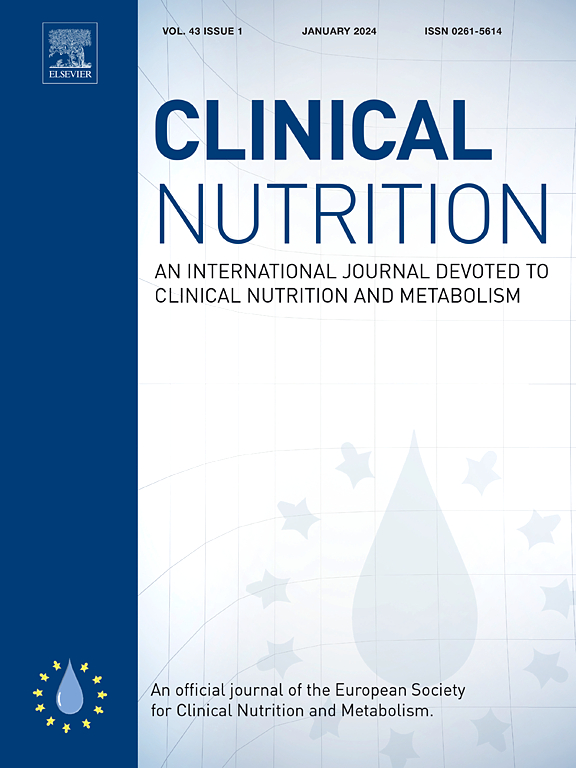Real-world evidence for an association of vitamin D supplementation with atherosclerotic cardiovascular disease in the UK Biobank
IF 6.6
2区 医学
Q1 NUTRITION & DIETETICS
引用次数: 0
Abstract
Background
Atherosclerotic cardiovascular disease (ASCVD) remains a substantial healthcare burden. The Australian D-Health trial recently showed potential efficacy of vitamin D supplementation (VDS) in reducing major ASCVD events. Whether the efficacy could be translated into real-world effectiveness is unclear.
Methods
Leveraging data from the UK Biobank, we used Cox regression with competing risk of all-cause mortality to assess the association of self-reported regular VDS (83.3 % from over-the-counter) and serum 25-hydroxyvitamin D (25[OH]D) levels with ASCVD as a composite endpoint and as separate endpoints including ischemic heart disease (IHD), cerebrovascular disease, peripheral arterial disease, and atherosclerotic disease.
Results
Among 409,822 study participants aged 40–69 years, 20.7 % were vitamin D deficient (25[OH]D < 30 nmol/L) and 34.4 % were vitamin D insufficient (25[OH]D 30-<50 nmol/L). Regular VDS was reported by 4.3 % of the study participants. During the follow-up of 15.9 years, 11.6 % of participants developed ASCVD. Compared to vitamin D sufficiency, vitamin D deficiency was associated with a significantly increased risk of the total ASCVD (hazard ratio [95 % confidence interval]: 1.10 [1.07–1.13]) and all separate ASCVD endpoints in the fully adjusted model with 48 covariates. Consistently, compared to non-users, VDS was associated with a reduced total ASCVD risk in the model fully adjusted for the 50 covariates (0.94[0.90–0.98]). Regarding the individual ASCVD disorders, VDS was associated with reduced IHD risk (0.90[0.86–0.96]).
Conclusion
Self-reported regular VDS and being vitamin D sufficient were both associated with reduced ASCVD risk in real-world settings. For people with low 25(OH)D levels, regular VDS may be a beneficial strategy for ASCVD prevention.
英国生物库中维生素D补充与动脉粥样硬化性心血管疾病相关的真实证据
背景动脉粥样硬化性心血管疾病(ASCVD)仍然是一个沉重的医疗负担。澳大利亚的 D-Health 试验最近显示,补充维生素 D (VDS) 对减少主要 ASCVD 事件有潜在疗效。方法利用英国生物库的数据,我们使用全因死亡率竞争风险的 Cox 回归评估了自我报告的定期 VDS(83.3%来自非处方药)和血清 25- 羟基维生素 D (25[OH]D) 水平与 ASCVD(作为综合终点)的关系,以及与缺血性心脏病 (IHD)、脑血管疾病、外周动脉疾病和动脉粥样硬化疾病等单独终点的关系。结果在 409 822 名 40-69 岁的研究参与者中,20.7% 缺乏维生素 D(25[OH]D 为 30 毫摩尔/升),34.4% 维生素 D 不足(25[OH]D 为 30 毫摩尔/升)。据报告,4.3%的研究参与者经常出现 VDS。在15.9年的随访期间,11.6%的参与者出现了ASCVD。在包含48个协变量的完全调整模型中,与维生素D充足相比,维生素D缺乏与总的ASCVD风险显著增加(危险比[95%置信区间]:1.10 [1.07-1.13])和所有单独的ASCVD终点相关。同样,在对50个协变量进行充分调整的模型中,与非使用者相比,VDS与ASCVD总风险降低有关(0.94[0.90-0.98])。结论在现实世界中,自我报告的定期VDS和维生素D充足都与ASCVD风险的降低有关。对于25(OH)D水平较低的人群来说,定期进行VDS可能是一种有益的预防ASCVD的策略。
本文章由计算机程序翻译,如有差异,请以英文原文为准。
求助全文
约1分钟内获得全文
求助全文
来源期刊

Clinical nutrition
医学-营养学
CiteScore
14.10
自引率
6.30%
发文量
356
审稿时长
28 days
期刊介绍:
Clinical Nutrition, the official journal of ESPEN, The European Society for Clinical Nutrition and Metabolism, is an international journal providing essential scientific information on nutritional and metabolic care and the relationship between nutrition and disease both in the setting of basic science and clinical practice. Published bi-monthly, each issue combines original articles and reviews providing an invaluable reference for any specialist concerned with these fields.
 求助内容:
求助内容: 应助结果提醒方式:
应助结果提醒方式:


